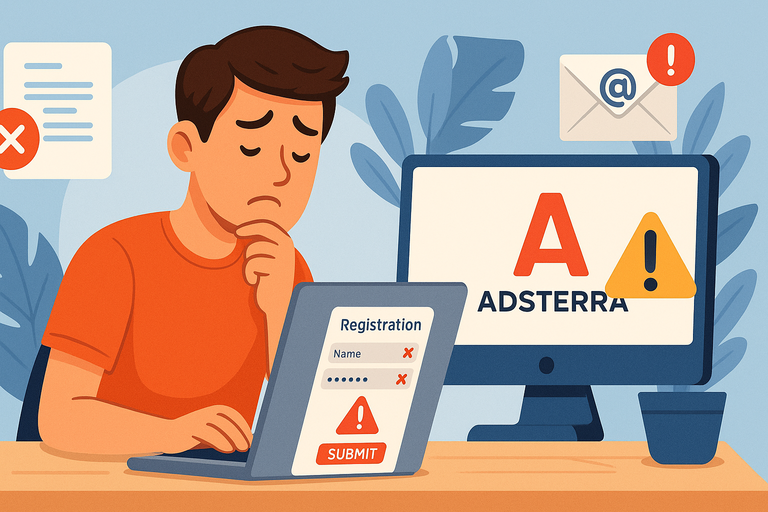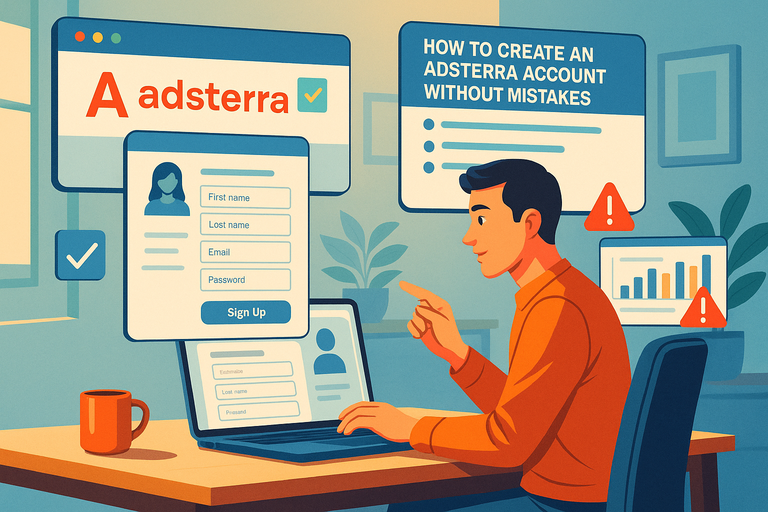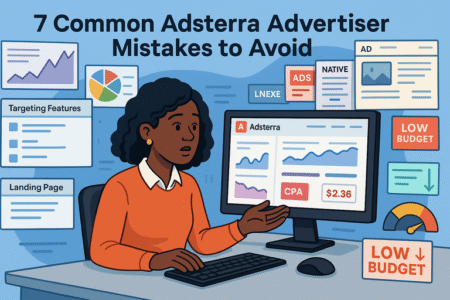Table of Contents
Creating an Adsterra account might seem like a quick task, but a single misstep can delay your approval or hurt your earnings later on. When I first signed up, I realized just how many small details could make or break your success with the platform.
Have you ever wondered why some publishers get instant approval while others get rejected or struggle with setup issues?
In this guide, I’ll walk you through exactly how to create an Adsterra account the right way—without the common mistakes that trip up beginners.
Understanding What Adsterra Is and Why You Need an Account
Before diving into setup, it’s important to know what Adsterra really is and why having an Adsterra account can be a valuable move—whether you’re a publisher looking to monetize traffic or an advertiser trying to reach new audiences.
How Adsterra Works for Publishers and Advertisers
Adsterra is a global advertising network that connects publishers (website owners, bloggers, app developers) with advertisers (businesses or marketers running campaigns). It’s like a digital marketplace for ads.
When you sign up as a publisher, Adsterra gives you ad codes—these are small snippets of HTML or JavaScript that you paste into your website or app.
Once active, ads automatically display to your visitors, and you earn money each time those ads are viewed or clicked, depending on the payment model (CPM, CPC, or CPA).
If you’re an advertiser, Adsterra helps you reach audiences through targeted campaigns. You can choose where your ads appear (by country, device, or category) and track your performance from the dashboard.
Example workflow for publishers:
- Sign up →
- Add your website →
- Get approval →
- Generate ad code →
- Place ads →
- Earn revenue.
I personally like Adsterra because it’s beginner-friendly and supports multiple ad formats—popunders, social bars, native banners, push ads, and more.
Each works differently, so you can experiment and find what earns best without any coding knowledge.
Key Benefits of Having an Adsterra Account
An Adsterra account opens up earning opportunities across virtually any niche. Here are some standout advantages:
- High Fill Rate: Adsterra claims over 100% fill rate globally, meaning your ad spaces rarely go empty.
- Multiple Ad Formats: You can mix formats like native ads or popunders to diversify income.
- Instant Approval for Some Sites: Many publishers get approved within hours.
- Timely Payments: They pay bi-weekly, and you can choose from PayPal, Bitcoin, WebMoney, or Paxum.
- Anti-Adblock System: Even users with ad blockers see your ads, boosting revenue.
I believe the biggest win is reliability. Adsterra has been around since 2013, serving billions of impressions monthly—this isn’t a fly-by-night platform.
Ready to start earning with Adsterra? Create your free account now and get approved fast.
Who Should Use Adsterra and Who Shouldn’t
From what I’ve seen, Adsterra suits people who already have consistent website or app traffic. If you run a niche blog, video streaming site, or download portal, Adsterra can monetize that traffic effectively.
You should use Adsterra if:
- You have organic or social media-driven traffic.
- You want flexible ad formats that don’t hurt user experience.
- You’re looking for an easy setup and fast payouts.
You shouldn’t use Adsterra if:
- Your site contains adult, illegal, or copied content (Adsterra rejects these).
- You’re just starting without traffic—approval might be difficult.
- You plan to use bots or fake traffic (they’ll suspend you immediately).
For anyone with real, engaged visitors, I’d say Adsterra is one of the most forgiving and profitable ad networks available.
Preparing Before You Create Your Adsterra Account

Before you hit that sign-up button, a little preparation can go a long way. I’ve seen many new users get rejected simply because they overlooked small but important details.
Checking Adsterra’s Eligibility Requirements
Adsterra’s approval process is automated but strict. Here’s what they typically look for:
- Original Content: Your site should have unique text and media—not copied.
- Functional Design: Avoid broken links, empty pages, or “coming soon” templates.
- Legitimate Traffic: No bots, redirects, or traffic exchanges.
- Safe Niches: Avoid adult, hacking, torrent, or illegal downloads.
I recommend spending 15–20 minutes auditing your site before applying. Make sure it loads fast and looks complete. A clean, professional layout improves your odds of getting approved.
Choosing the Right Website or Traffic Source for Approval
When you sign up, Adsterra asks for your main traffic source (e.g., website, mobile app, or social page). This is a crucial step because it determines how your account is reviewed.
If you have multiple websites, start with your best one—the one that receives the most traffic or has consistent content. Once approved, you can add more sites later under the same account.
Here’s a simple path that works well:
- Choose your primary website or app.
- Add content that matches your audience’s intent.
- Include an “About” and “Contact” page to signal legitimacy.
For social traffic, Adsterra may ask for extra verification, especially if you’re monetizing platforms like Telegram or Facebook groups.
Avoiding Common Pre-Registration Mistakes
Many users rush through signup, only to face rejection later. Here are some mistakes I’ve seen repeatedly:
- Using free domains (like Blogspot or Wix). It’s better to have a custom domain—it signals trust.
- Submitting incomplete websites. A half-finished site looks unprofessional.
- Using temporary emails. Always use a genuine email; it’s your verification lifeline.
- Ignoring Adsterra’s terms. Skipping their guidelines can get you blacklisted.
In short, treat the registration like a job application. Small details count.
Step-by-Step Process to Create an Adsterra Account
Creating your Adsterra account is straightforward once you know the right steps. I’ll guide you through the exact process I’ve used personally.
How to Access the Official Adsterra Registration Page
Start by going to the official Adsterra website (www.adsterra.com). Click on “Sign Up” in the top-right corner. You’ll see two main options:
- Publisher: For earning from website or app traffic.
- Advertiser: For running ad campaigns.
Most beginners should select “Publisher.”
Quick tip: Bookmark the login page (https://publishers.adsterra.com) once you register—it’s easy to lose track later.
Filling Out the Registration Form Correctly
Here’s where most mistakes happen, so let’s go step by step.
You’ll see fields like:
- Full Name: Use your real name.
- Email Address: Must be active; this is where your approval mail goes.
- Password: Use a strong one (Adsterra enforces this).
- Account Type: Choose “Publisher” unless you’re buying ads.
- Website URL: Enter your primary website (with https://).
Once you’ve filled everything, check the “I agree to the terms” box and hit Sign Up.
From my experience, it’s better to double-check your domain spelling before submitting—it’s a common cause of rejection.
Verifying Your Email and Activating Your Account
Right after signing up, you’ll get a verification email from Adsterra. Open it and click “Confirm My Account.”
Once confirmed, you can log in to your dashboard. You’ll then see a section to add your website or traffic source.
Approval usually takes a few hours (sometimes up to 24 hours). If your site meets all requirements, you’ll get an email saying your account and website are approved.
Here’s the short workflow after approval:
- Log into your Adsterra dashboard.
- Click Websites → Add New Website.
- Choose your ad formats (Popunder, Social Bar, Native Banners, etc.).
- Copy the ad code.
- Paste it into your site where you want ads to appear.
Once live, your ads start showing and your revenue tracking begins immediately.
Setting Up Your Adsterra Profile the Right Way
Once your Adsterra account is created, the next step is to set up your profile properly.
Think of this as polishing your online business card—small details here can influence your approval rate and how smoothly your account operates later.
Entering Accurate Personal and Website Information
When you log in for the first time, you’ll land on your Adsterra dashboard, where you can access your profile settings by clicking your name in the top-right corner → Profile Settings.
I can’t stress enough how important it is to use real, consistent information. Adsterra takes accuracy seriously—fake names or mismatched payment details can delay approvals or even block your earnings.
Here’s what to pay attention to:
- Name and Email: Must match the credentials you’ll use for payments.
- Country and Time Zone: These affect reporting accuracy and payout eligibility.
- Website URLs: Add only websites that truly belong to you or that you manage.
- Traffic Type: Choose the correct one (e.g., SEO, social, direct).
I suggest filling everything honestly the first time around—it’s easier to get verified once than to fix rejections later. For example, if you list “social media traffic” but your site barely has a Facebook page, it might raise red flags.
One little insider tip: Always ensure your email domain matches your brand if possible (like name@yourdomain.com). It adds instant credibility.
Selecting the Correct Account Type (Publisher or Advertiser)
Adsterra gives you two main account types—Publisher and Advertiser—and selecting the right one determines what your dashboard looks like and what tools you can access.
If you want to earn money from your website or app, choose Publisher. You’ll get access to ad codes, traffic statistics, and earnings reports.
If you plan to promote your own products or run ads, choose Advertiser. That option unlocks campaign setup tools, targeting options, and performance analytics.
It’s worth noting that Adsterra allows you to switch or even hold both types under one email, but I recommend starting with one focus to keep things organized.
In the Publisher dashboard, you’ll see menu items like:
- Websites: Where you add and manage sites.
- Ad Codes: To generate ad units.
- Statistics: For tracking impressions and revenue.
- Payments: For withdrawal requests and payment history.
Knowing your purpose before setup helps you avoid clutter and speeds up your workflow.
Understanding Dashboard Features and Navigation
Adsterra’s dashboard is fairly intuitive once you get familiar with the layout. On the left-hand panel, you’ll see tabs like Websites, Statistics, Payments, and Support.
Here’s a quick breakdown of what each section does:
- Websites: Add new sites or apps. Each entry goes through a review process.
- Ad Codes: Create and customize ad formats like popunders, native banners, or push notifications.
- Statistics: Track impressions, clicks, CTR (click-through rate), and earnings in real-time.
- Payments: View your balance, choose payout methods, and check payment status.
- Support: Directly contact Adsterra’s support team if you face approval or technical issues.
One feature I really appreciate is the live analytics—you can see which ad zones perform best almost instantly. If you’re managing multiple traffic sources, this data helps you adjust placements and increase revenue efficiently.
Pro tip: Spend a few minutes clicking through every menu before adding your first ad. Familiarity saves time later when you start optimizing performance.
Common Mistakes to Avoid When Creating an Adsterra Account

Getting approved by Adsterra is not hard, but it does require attention to detail. From what I’ve observed, most rejections happen because of completely avoidable mistakes.
Using Fake or Inconsistent Information
This one’s a dealbreaker. Adsterra cross-checks your profile data, payment info, and email verification. Using different names or unverified emails might seem harmless, but it’s a fast way to get flagged.
Here’s what to do instead:
- Use your real name and accurate country.
- Avoid using VPNs during registration.
- Ensure your payment method matches your profile (e.g., same PayPal name).
Think of Adsterra as a financial platform, not just an ad network—they have to verify who they’re paying. A clean, truthful profile builds long-term trust.
Ignoring Email Verification or Account Confirmation Steps
After signing up, Adsterra sends you a verification email. Skipping this step keeps your account in a “pending” state. I suggest checking both your inbox and spam folders after signing up—sometimes that email hides there.
Once confirmed, log in and check if your account status says “Active.” Without that, your site won’t get reviewed, and your ad codes won’t work.
If you don’t receive a confirmation within an hour, reach out via support@adsterra.com—they’re responsive and can manually verify your account.
Submitting Low-Quality or Non-Compliant Websites
Adsterra reviewers are trained to detect spammy or unfinished sites. A website that looks empty, copied, or unsafe will almost always get rejected.
To avoid this:
- Make sure your homepage loads quickly (under 3 seconds).
- Add at least 5–10 original blog posts or content pages.
- Avoid sites with adult, gambling, or hacking material unless you’re applying for their Adult Network branch (which requires separate approval).
If your site’s purpose is clear and it offers real value, you’re already halfway to approval.
I once tested a minimal blog with thin content, and it got rejected immediately. After adding proper articles, a privacy policy, and contact info, it was approved the next day. That’s how much presentation matters.
Tips to Get Fast Approval from Adsterra
Now that we’ve covered what not to do, let’s talk about what actually helps you get that green “Approved” status faster.
Optimizing Your Website for Adsterra Review
The first thing Adsterra looks for is quality. A few tweaks can dramatically improve your chances.
- Improve site loading speed: Use tools like Google PageSpeed Insights to fix slow pages.
- Clean, mobile-friendly design: Responsive themes perform better.
- Add key pages: About, Privacy Policy, Contact, and Terms of Service pages are must-haves.
- Remove broken links: They signal neglect.
When I helped a friend optimize his WordPress site before applying, just adding a few structure pages and cleaning the layout turned a previous rejection into approval within 12 hours.
Using a Custom Domain Instead of Free Hosting
This is one of the most underrated but powerful tips. Adsterra rarely approves websites hosted on free domains like example.blogspot.com or example.wixsite.com.
A custom domain (like yourwebsite.com) instantly adds legitimacy. You can get one for less than $10 a year from providers like Namecheap or GoDaddy.
Why it matters:
- It signals long-term intent.
- It gives you professional email options (like support@yourdomain.com).
- It helps avoid the “spammy site” impression.
If you’re serious about monetizing with Adsterra, this small investment pays off quickly.
Maintaining Clear Navigation and Original Content
When Adsterra’s system or human reviewers visit your site, they judge usability first. A confusing layout or plagiarized content signals poor quality.
Here’s how to make your site reviewer-friendly:
- Use a simple menu: “Home,” “About,” “Blog,” “Contact” works perfectly.
- Add internal links: It helps users (and Adsterra bots) understand structure.
- Write your own posts: Even rewriting articles in your own tone makes a difference.
I advise spending a day refining your website before applying. Add meaningful images, improve titles, and ensure every page feels natural. Remember—first impressions matter, even to algorithms.
Troubleshooting Adsterra Account Registration Issues
Even if you’ve followed every step carefully, sometimes your Adsterra account might not get approved on the first try.
Don’t panic—it happens to many new users, especially if it’s your first time monetizing a website. The good news is that most issues are fixable with just a few tweaks.
What to Do If Your Account Isn’t Approved
If your Adsterra account isn’t approved, the first thing to do is read the rejection email carefully. Adsterra usually specifies why your application didn’t pass.
The most common reasons include incomplete sites, low-quality content, or non-compliance with their policies.
Here’s what I recommend doing right after rejection:
- Check your website: Make sure it’s live, has unique content, and loads properly.
- Review Adsterra’s rules: They have strict guidelines against adult, illegal, or deceptive content.
- Fix the mentioned issues: Whether it’s about design, speed, or missing pages—address them one by one.
For example, a friend of mine got rejected because his site was under construction. Once he added proper articles and a contact page, he reapplied and was approved within a day.
If you don’t see a clear reason in the email, log in to your dashboard and check the status of your site—it often shows additional notes.
How to Contact Adsterra Support for Help
Adsterra’s support team is surprisingly responsive. If you’re unsure why your account wasn’t approved, you can reach out directly for clarification.
Here’s how:
- Log in to your Adsterra dashboard.
- Click on the Support tab (left-side menu).
- Choose “New Ticket.”
- Write a short, polite message asking for feedback on your application.
You can also email them at support@adsterra.com if you prefer direct contact.
In your message, mention your account email, website URL, and that you’d like detailed feedback for improvement.
I suggest keeping the tone friendly and professional—support teams are much more willing to help when they sense you’re genuinely trying to fix issues.
I once got a personalized reply within three hours—they even pointed out which parts of my website needed fixing. That kind of guidance is incredibly useful when you’re just starting out.
Reapplying the Right Way After a Rejection
Once you’ve fixed all the issues, don’t rush back to reapply immediately. Take a day to review your site again from an outsider’s perspective.
Follow these simple steps to reapply correctly:
- Log in to your Adsterra dashboard.
- Go to Websites → Add New Website.
- Submit your improved website for review.
If your old site was rejected, you can still reapply with the same one—just make sure the changes are visible. Adsterra doesn’t penalize you for retrying.
I suggest writing a short note in the website submission form like “I have improved site content and design as per previous feedback.” It shows responsibility and increases your approval chances.
Patience pays off here. Adsterra usually reviews reapplications faster if they see genuine improvement.
Securing and Managing Your New Adsterra Account

Once your Adsterra account is approved, your focus should shift to managing it safely and efficiently. Many new users forget that this is a real business platform handling money—so treating it professionally matters.
Updating Account Information Safely
You can edit your account information anytime by logging in and clicking Profile Settings in the top-right corner.
When updating details:
- Always double-check your payment address or wallet ID before saving changes.
- Avoid using public computers or shared Wi-Fi when logging in.
- Keep your login credentials private—Adsterra will never ask for your password via email.
I recommend enabling two-factor authentication (2FA) if available. It adds a layer of protection against unauthorized access.
If you change your payment method (for example, from PayPal to Bitcoin), contact support to verify the update. This ensures there are no payout delays.
Protecting Your Account from Fraud or Suspension
Adsterra maintains strict anti-fraud policies, which is good—it keeps the network healthy and trustworthy. However, this also means careless actions can get your account suspended.
Avoid the following at all costs:
- Sending fake or bot traffic.
- Clicking your own ads (yes, they track that).
- Placing ads on unauthorized sites.
- Using misleading pop-ups or redirects.
If Adsterra detects suspicious activity, they might freeze your earnings temporarily for review. To prevent this, keep your traffic sources transparent.
I suggest checking your traffic analytics regularly. If you see strange spikes or non-human behavior (like thousands of clicks from one country overnight), investigate immediately. It could save your account.
Keeping Track of Your Earnings and Payments
Your Adsterra dashboard includes a Statistics section where you can monitor all your earnings in real-time. You’ll see metrics like:
- Impressions (number of ad views).
- Clicks.
- CTR (Click-Through Rate).
- CPM (Cost Per Thousand Impressions).
- Total Revenue.
Payments are made bi-weekly, and you can choose from methods like PayPal, Bitcoin, Paxum, or WebMoney.
To check your balance:
- Click Payments → Balance & History.
- Select your payment method.
- Verify payout dates and minimum thresholds.
From my experience, Adsterra has one of the most reliable payout systems in the industry. Just ensure your profile information matches your payment method, or your payment might get delayed.
Best Practices After Creating Your Adsterra Account
Having an approved Adsterra account is a good start—but turning it into a consistent source of income requires smart management. Let’s go through what works best once you’re live.
Testing Different Ad Formats and Placements
Adsterra offers multiple ad formats: popunders, social bars, native banners, push notifications, and direct links. Each performs differently depending on your audience and website layout.
I recommend experimenting with at least two formats at a time. For example, try combining social bar ads (which blend naturally into your site) with native banners. Monitor which one earns better using the Statistics tab.
If you’re running a blog, avoid overloading the page with ads—it might slow down loading and hurt SEO. Instead, test ad positions gradually to find your “sweet spot.”
You can also request advice from your Adsterra manager—they often provide personalized suggestions based on your traffic type.
Monitoring Performance Through Analytics
The secret to scaling earnings lies in tracking results closely. Adsterra gives detailed analytics, but I suggest connecting it with Google Analytics or Matomo for deeper insights.
Here’s what to track regularly:
- CTR trends (if it drops, try repositioning your ads).
- Country-wise performance (some regions pay higher CPM).
- Device breakdown (mobile vs desktop traffic).
Once, I noticed my mobile traffic brought 60% of clicks but only 40% of earnings. Adjusting my ad format to mobile-optimized push ads instantly improved results by 25%.
Numbers tell stories—follow them.
Staying Compliant with Adsterra’s Policies
To keep your account safe long-term, it’s important to stay compliant. Adsterra regularly updates its policies to prevent fraud and improve user experience.
Keep these simple rules in mind:
- Don’t modify Adsterra’s ad codes manually.
- Avoid deceptive redirects or download prompts.
- Don’t use copyrighted or adult content unless approved.
- Disclose ads clearly if required in your region.
Whenever Adsterra releases an update (you’ll usually get an email), take a few minutes to read it. Staying informed keeps you one step ahead of trouble.
Pro Tip: How to Maximize Earnings After Account Setup
Once you’re comfortable managing your Adsterra account, the real fun begins—optimizing for maximum revenue. Let’s look at a few tested strategies that can help you grow faster.
Experimenting with CPM and CPA Offers
Adsterra lets you earn in different models like CPM (Cost Per 1,000 impressions) and CPA (Cost Per Action).
- CPM ads pay you for every thousand views—great for high-traffic sites.
- CPA offers reward you when users perform actions, like signing up or downloading apps.
I suggest starting with CPM to build consistency, then testing CPA campaigns once you understand your audience. You can find these under Ad Codes → Offer Types in your dashboard.
Smart publishers often blend both to diversify revenue—steady CPM income plus the occasional CPA boost.
Using Smart Rotations to Increase CTR
If you notice some ad zones underperforming, try smart rotation—it automatically rotates different creatives to find which performs best.
To activate it:
- Go to Ad Codes → Create Zone.
- Choose Smart Rotation from the ad type options.
This feature helps you discover what truly engages your audience without constant manual testing. It’s like having an AI assistant for optimization.
I tested this on a tech blog and saw CTR rise from 1.3% to 2.1% in a week. Small tweaks can lead to big gains.
Building Long-Term Traffic for Steady Income
No ad strategy beats consistent, organic traffic. I suggest focusing on content and SEO in parallel with your Adsterra setup.
Simple habits that work:
- Publish regularly (even one quality post per week helps).
- Build backlinks from trusted sites.
- Engage your readers through email or social media.
Think of Adsterra as a long-term partner, not a quick cash machine. The more authentic your content and audience, the higher your earnings potential.






